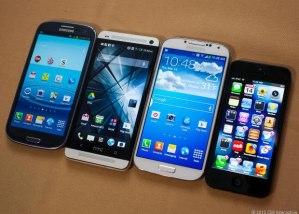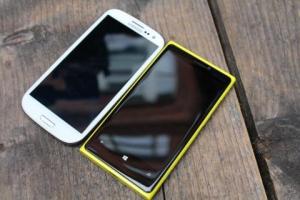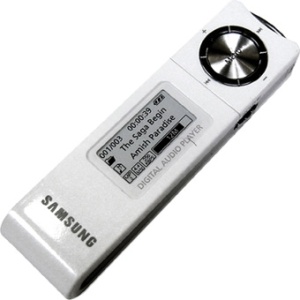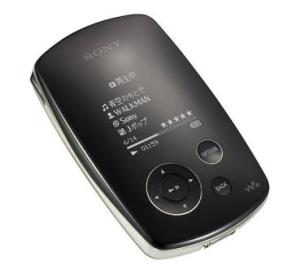SXSW has hit its peak for this year with the unveiling of the Galaxy S4. I’m quite the fan of big tech events and I was glued to this feature in particular, even going to the pathetically extreme length of getting the RSS updates from Gizmodo. How sad is that? I sort of have my reasons. Last April I took the ball-aching step of signing up to a phone contract. This was by far the most commitment I’ve ever shown to anything, ever. Every job I’ve ever worked, every flat I’ve ever lived in and every situation I’ve ever gotten my lazy self into has been characterized by one principle: I could walk away at any time. I fear commitment. I run from it. I tremble and shudder whenever somebody says I can’t leave the room, for god’s sake. I have emotional claustrophobia. But a phone contract? That shit follows you around. Those companies have ways and means of tracking you down. They’re all-powerful. Hell, they successfully dodge tax without going to jail. They do not fuck about.
So I signed on the dotted line (or rather, because this is the digital age and I don’t remember the last time I even saw a pen, never mind used it to make marks on paper, I filled in my credit card details) with immense trepidation. It was my first step into adulthood. And not three days later, my even-for-the-time outdated iPhone 4 (I was working civil servant’s wage at the time) showed up in a nice, spare box. I fell in love. Technology officially peaked for me with something made of glass and aluminium that showed me dirty movies and my twitter feed. I was happy. The gaping consumer hole in me had been plugged. The urge to break a window and use the shards to cut my arteries was temporarily abated. Life is far less grim, painful and hateful if you can play Angry Birds on the toilet. I had found my comfort zone.
Or so I thought, because not two months later two new smartphones were released, and the cycle started all over again. The Lumia and the Galaxy became my new objects of lust. I still haven’t upgraded. I can’t. My phone is the cellular equivalent of a crazy bitch who burns all of your furniture and you can’t break up with her because she’s just too pretty. I am consumed by my Rubik’s complex and my need to fix and heal. But that doesn’t stop me from looking at other models. And the Galaxy series is the playboy catalogue I keep hidden under my mattress.
(For my younger readers, a long time ago porn used to be printed on a tree. No, really. Seriously. Ask your dad. And then ask your mum about all the drugs she took when she was attending that liberal college. She used to party real hard, if you know what I mean.)
I lust pretty hard for the Galaxy series because they’re the complete opposite of the phone I own. The iPhone is the triumph of style over substance, of form over function, a gross perversity of design. It’s a Bluefin Tuna that handles like a piano. It’s a Cheetah with a dick leg. It’s bloody useless and very pretty to look at. The Galaxy series is the complete opposite of that. It looks like shit – plasticky, gimmicky, injection-moulded, flexible polycarbonate shit. And it works like a dream. It is a truly beautiful piece of technology. This is me lusting over the fat girl with beautiful eyes who can sing, write poetry and weld, while the useless, psychotic supermodel dummy lurks in the background. It’s a nightmare scenario.
All of this waffle is building towards a point, believe it or not. The point is design. The point is that there are choices we have to make in life. We can have the people carrier that looks like a shed but will never break down, or we can have the supercar that gets stuck on speed bumps. It’s very rare that the two come together in this world. That is a lamentable situation, true, but there’s a good reason for it: companies are either run by designers or by engineers. Samsung is an example of a company run by engineers. They make horrible, plastic crap. They always have. I remember the first time I saw a Samsung product. It was 1991 and the product was a shitty-looking microwave. It had a horrible jingle, too:
“Making kids a meal, will make you squeal, without a Saaaaaamsung,
Making yourself a bite, would take all night, without a Saaaaamsung!”
The next time I saw Samsung they were pushing out those awful USB MP3 players that didn’t let you choose tracks. Samsung were bargain basement, man. They were the lower end of the market. Their products reeked of ARGOS.
At the same time, Sony was producing a Walkman of such aching, breathtaking beauty that seeing someone with one made me jealous enough to kill. It was a sleek pebble of metal and plastic with a hidden display that shone through. It looked like space technology.
There was one critical difference: The Samsung worked. It worked perfectly. My sister still has one. She doesn’t use it, but I’ve checked it out. It works. The Walkman didn’t work. It didn’t work out of the box and it sure as hell doesn’t work now. Realising the difference at the age of fifteen made me aware of a fundamental principle of design: design is useless if the product doesn’t work, and solid engineering is unappreciated if it doesn’t come nicely packaged.
Let’s take another case in point: Google Glass. Google’s augmented reality is already taking small parts of the world by storm. The idea of walking around constantly connected to the vast tentacles of the internet is appealing to nerds of every kind. Google Glass offers nerds exactly the sort of reality they’ve always wanted: a reality full of pop-ups and heads-up displays. A reality where they can google chat-up lines while talking to a pretty girl. A reality that allows them to surreptitiously browse for porn on the bus. A reality where they can take photographs surreptitiously. Google Glass is the product of many, many years of R&D, and it’s set to take the world by storm. The first model sold for $15,000 on Ebay. The more recent models are likely to retail at $1,500 apiece.
Or so the nerds think. May I, for a moment, offer an alternative scenario? Google Glass is a visionary product – truly clever. But nobody will buy it. Well, alright, some will. But they won’t wear it out. They’ll look like idiots or perverts or both. Nobody wants to look like an idiot or a pervert. The failure of Google Glass isn’t in exploring a new market – personalised heads-up displays and on-the-fly connectivity – it has shown us one possible glimpse of the future. The failure if Google Glass is that it looks stupid. Really, really stupid.
People look like Borgs on the make when they wear Google Glass. In fact, they look worse. They look like this guy.
There is no outfit it goes with. There is no accessory it complements. As a piece of fashion wear it doesn’t have a future. Alright, alright, no doubt I’ll be proved wrong in the long run, because augmented reality is set to take over everything, but will people wear this specific product? I really doubt it. It’s a design fraught with problems. It’s not waterproof. It would be the easiest thing in the world to steal or break. A guy has already been assaulted for wearing it . It contains a strong element of covert surveillance.
If I’m building to any particular point here, it’s that form and function have to go together. A bad product with good design is all packaging and no product. A good product with bad packaging is going to suffer. The ideal product, whatever it is, needs to have both.
People don’t want something that just works. They want something the fills their aspirational need. They want something with a brand identity and a tolerable uniqueness. That’s why idiots like me buy iPhones : because we’re attracted to form over function. In an ideal world, I guess, everything would look rubbish, like the Galaxy, and work perfectly (sort of like the Galaxy). But humans are vain and drawn to the beautiful and boring. It’s in our nature. We are a visual species. That’s why it took Samsung years to claw ahead of Apple in the markets, only to lose their lead once the iPhone 5 was released. Ultimately, it’s why Apple will always dominate the market in some way. Because they make beautiful crap. And we like beautiful crap.
I think I did have a point but I’ve wandered away from it. Make your own mind.








Beautiful post.
grazie mille
Prego.
What have you been doing with my old MP3 Player? If I listen to it will it be filled with a repeating loop of ‘this week i will be mostly wearing yoghurt!’
Hahaha oh my god I so wish I’d done that. No. I just turned it on to check.
Yeah I kind of wish you’d done that too.
Pingback: Time for a "chest" thread - Page 304 - Pelican Parts Technical BBS·